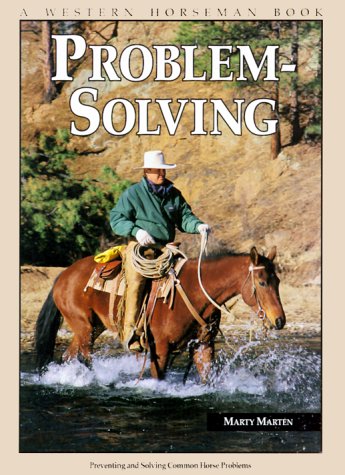Volume 2 is a continuation of Volume 1 with chapters covering problems such as those surrounding halter-breaking, bridling, saddling, mounting, hoof and leg handling, trail riding, and many others. Prevention and good horsemanship skills are heavily stressed making these books useful to anyone whether or not they have the problem discussed.
The methods and philosophy the author presents are based on how horses think, learn, and communicate naturally. Rather than make a horse do what is asked, Marten's approach sets up the training so the horse can search for the right answer, which is in the path of least resistance. The horse's slightest try is rewarded by the handler's or rider's immediate release of pressure.
Volume 1 lays the foundation for all good riding with techniques and exercises that are time-tested and proven. Chapters include common ground-handling problems such as being hard to catch and pulling back when tied, typical riding problems such as spooking and crossing water and the solutions to the ever-common problem of trailer loading.
The books stress the theme that no problem is a singular event by itself. It's instead part of the overall common thread throughout a rider's interaction with his or her horse. Therefore, all problems lead back to building or rebuilding a stronger foundation, both on the ground and in the saddle. Volume 1 and 2 give specific approaches to accomplish a higher degree of horsemanship and understanding of equine behavior. As a result, the horse owner is safe and enjoys his or her horse more.
Problem Solving, Volume 2 is a continuation of Marty Marten's popular first book on solving common horse behavior problems both in the saddle and on the ground. Chapters address such issues as: halter-breaking; hoof and leg handling; cinchy and difficult-to-saddle horses; mounting problems; head-shy, ear-shy, hard to bridle horses; problems riding one-handed, neck-reigning; trail-riding problems and distractions; good trail-riding habits and techniques; developing trust and confidence through cattle work.
Like Problem Solving, Volume 1, this book stresses the theme that no problem is a singular event. Instead, it is part of a common thread throughout a rider's interaction with his or her horse. All horse difficulties, therefore, lead back to building or rebuilding a stronger foundation, both on the ground and in the saddle. This book, along with Volume 1, gives specific guidelines for attaining a higher level of horsemanship and understanding of equine behavior. As a result, the horse owner will be safer and derive more enjoyment from his or her horse.
